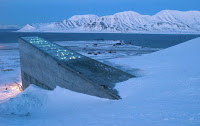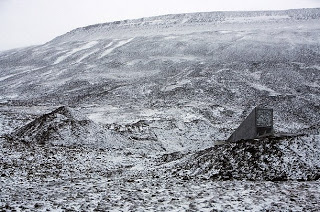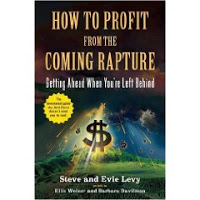New York after the Apocalypse: The Art of Alex Lucas
Posted by vonnagy on Jul 16 2009
Alex Lucas paintings depict New York under water – very interesting stuff, click here or the image below:
Alex Lucas paintings depict New York under water – very interesting stuff, click here or the image below:
 These days Vikings are pillaging the world’s seed supply (with the approval of all nations) so the world can replenish its plant life in case the of its annihilation here on earth.
These days Vikings are pillaging the world’s seed supply (with the approval of all nations) so the world can replenish its plant life in case the of its annihilation here on earth.
Read more here: http://www.scientificamerican.com/article.cfm?id=seeds-of-future-agriculture-enter-doomsday-deep-freeze
A barren, treeless island in the Arctic archipelago of Svalbard may prove to be the last, best hope of agriculture in warmer, more fertile parts of the world. The first batch of 100 million of the most important agricultural seeds were placed into the doomsday repository there today. The Svalbard Global Seed Vault is buried deep within a frozen mountainside near the Norwegian town of Longyearbyen that perpetually cools it to –18 degrees Celsius (–0.4 degree Fahrenheit) with or without permafrost. Built to withstand all foreseeable disasters, including a recent earthquake that was the biggest in Norwegian history, it has room to protect at least 4.5 million samples (2.25 billion seeds) in its three man-made caverns.
“The opening of the seed vault marks a historic turning point in safeguarding the world’s crop diversity,” says Cary Fowler, executive director of the Rome-based Global Crop Diversity Trust, which led the project. “Crop diversity will soon prove to be our most potent and indispensable resource for addressing climate change, water and energy supply constraints, and for meeting the food needs of a growing population.”
Rice was the first staple to be stored in the vault—strains from 104 countries around the globe. Sealed in airtight foil packages and encased in boxes, the seeds will remain viable but dormant in the low temperature and humidity conditions.
Wheat, maize, potato, bean and even watermelon seeds will be placed in Svalbard in coming weeks. All told, 268,000 different varieties from Canada, Columbia, Mexico, Nigeria, Pakistan, the Philippines and Syria, among others, will be the first to enter the deep freeze.
The vault is designed to protect against global-scale disasters—human or natural—that could potentially wipe out agriculture. Similar local seed banks have allowed farmers to recover from recent wars in Afghanistan and Iraq as well as provided new varieties capable of growing in changed conditions, such as rice strains that thrive in fields that had been inundated with saltwater after the Asian tsunami in 2004.
“Gene banks are not seed museums but the repositories of vital, living resources that are used almost every day in the never-ending battle against major threats to food production,” says Emile Frison, director general of Bioversity International. “We’re going to need this diversity to breed new varieties that can adapt to climate change, new diseases and other rapidly emerging threats.”
Such gene banks are themselves vulnerable. For example, a typhoon in 2006 wiped out the Philippines’s national rice seed repository. “Unfortunately, these kinds of national gene bank horror stories are fairly common,” Fowler says.
The Svalbard Global Seed Vault is meant to be the backup of last resort, stocked with copies of different crops from national seed storage facilities. For example, the U.S. Department of Agriculture’s National Germplasm System plans to send more than a million seeds to the vault, including sweet pepper, squash and tomatoes.
In the vault’s cold isolation, the seeds can keep for hundreds and thousands of years—the grain sorghum alone can last for 20,000 years—effectively allowing agriculture to be restarted in the event of a global calamity, such as nuclear war or catastrophic climate change. But the vault will require some vestiges of human civilization to persist, if only to build the transportation to bring the seeds back out of their new icy home.
“The world’s crop gene pool contained in seeds is essential for increasing crop productivity; mitigating climate change, pests and diseases; and ensuring a genetic resource base for the future,” said Jacques Diouf, director general of the United Nations Food and Agriculture Organization, in remarks prior to the opening of the vault. “Seeds are the vehicle of life.”

Don’t let a little radiation get ya down? Just mosey on down to your local fallout shelter – its just like home! check these great scan from The Ward O Matic website and also the screenshots from Popular Science from December 1961 found on google books. Enjoy!
Here’s a great site to view what could happen after the Apocalypse – Opacity.com. Here are beautiful photos of abandoned factories, miltary installations, mental institutions and more.
A small preview below:
Peenemünde is a small German village located on Usedom island on the Northern coast of Germany, and was selected to become a rocket proving ground and research facility after a site at Kummersdorf proved to be too small. The Reich Air Ministry paid 750,000 reichsmarks to purchase the entire northern peninsula of Usedom island in 1936 to develop two major areas of a secret base – the Army Research Center and rocket site on the eastern side, and a Luftwaffe test site on the west.
Camp Bluefields was built in 1910 as a training academy/rifle range for the National Guard. By 1913 problems arose as the bullets rained down upon the residents of Grand View On Hudson, and after multiple complaints and fires, it was shut down. From 1913 to 1918, it was used by the New York YWCA as a womens camp, then it returned to its use as a training camp in 1918 in preparation for World War I.
Resting in the Hudson River, on Pollepel Island, is a crumbling hulk of intricate concrete and brickwork that was once Bannerman’s Arsenal. In 1900, Francis Bannerman VI bought the island to store ammunition for his prosperous military surplus business; more specifically, when he bought 90% of the US army surplus after the Spanish-American War ended and needed a place outside of New York City to store it all. The arsenal (sometimes referred to as “Bannerman’s Castle”) was constructed from 1901 to 1908, and was modeled similar to the architecture of an old Scottish castle.
 The Apocalypse got you down? Need to make a spare buck or two now that all your rich Christian friends have been given a free ride to heaven? Well despair now longer, we have a book for you!
The Apocalypse got you down? Need to make a spare buck or two now that all your rich Christian friends have been given a free ride to heaven? Well despair now longer, we have a book for you!
Taking on the religious, political and consumer force of the modern End Times movement, comic authors Weiner and Davilman (Yiddish with Dick and Jane) turn out their sharpest satire yet with a hysterical step-by-step financial guide for those “left behind” by the Rapture-when, according to literal interpretations of the New Testament, the faithful will be whisked bodily to Heaven by Jesus. The authors chart their way through the Rapture and Tribulation, using actual bible verses and scholarship (Tim LaHaye, bestselling author of the Left Behind series, is quoted often) to chronicle the series of plagues that make up the end of the world (war, famine, a fiery mountain in the sea, invisible horse-shaped locusts), and their considerate plans for making money in the aftermath. At times laugh-out-loud funny, this skewering volume is also a sobering look at the beliefs of many Americans, but Weiner and Davilman employ irreverence without insult, handling the highly-charged topic with a surprisingly light touch. Illus.
Click below to go to Amazon and get the book